If you are a sheep farmer or hope to have a flock one day, understanding the different medications and antibiotics for sheep that exist, and how to administer them is essential. In this guide, we will go over the different types of medication for sheep, important medications to have on hand for sheep, and dosage charts for sheep antibiotics and other commonly used medications.
Remember, always consult with a veterinarian before making decisions on medication for your sheep. This article is designed to provide general guidance and information only, and should not be taken as a replacement of or substitution for advice from a trained veterinarian.
| RaisingSheep.net is reader supported. If you make a purchase after clicking a link, I may earn a commission at no additional cost to you. |
Types of Medications for Sheep
Let’s take a look at the topical, injection, and oral medications commonly given to sheep. We will discuss what these medications do and how they work.
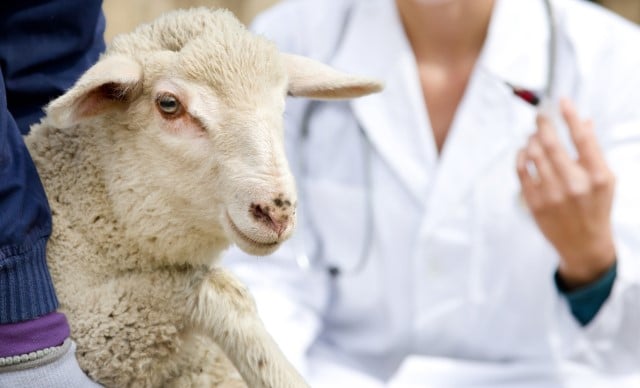
Of course, a drug is a product that we use to treat an illness or even to prevent one. When it comes to sheep, drugs can be instrumental in preserving an individual sheep’s health and can even be necessary for ensuring the well-being of the flock as a whole.
Remember that medications must always be used responsibly and with full knowledge of what is being administered. As a sheep producer, you should try to minimize medication use in your flock as much as you can, while of course not risking animal health. Never attempt to make medication a replacement for proper feeding practices and flock management.
If you are in the United States, you should know that drugs are either approved or disapproved by the FDA (Food and Drug Administration). While there are some medications that you can buy OTC (over-the-counter) and without approval from a veterinarian, other types of medication can only be obtained with a prescription.
You can find OTC drugs from a variety of sources, including veterinarians, farm and feed supply stores, and even the internet. If you go the internet route, make absolutely certain that you are buying from a highly reputable source. If you buy prescription drugs, you will probably have to buy them directly from a vet.
Get Veterinarian Approval for Any Extra-Label Use
Sometimes medications are used for purposes outside of what is specified by the producer or manufacturer. However, this should only be done with clear veterinary approval. Prescription drugs can only be used for extra-label use if a veterinarian prescribes it and approves that use.

Even with OTC drugs, you should not use them for an extra-label use without consulting with a veterinarian and getting their approval. In general, extra-label use of drugs is only allowed when it’s necessary for the animal’s health and there is no alternative for dealing with the problem.
You are never allowed to use unapproved drugs for “off-label” utilization, whether to control reproduction or boost performance. This is strictly prohibited and will harm your animals.
Proper Use of Medications is Key
Even if you are going to use a drug that is approved for your animals, it is considered extra-label use if you are administering a higher dose than specified or you are giving it to your animals in a different way than instructed.
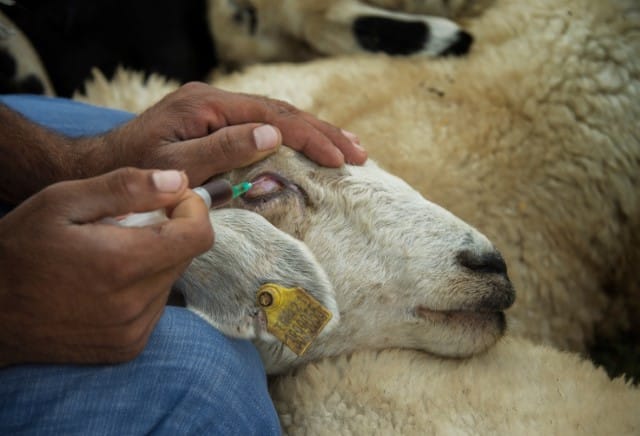
This is only allowable if there is no alternative for treatment and animal health is in real jeopardy. You are never allowed to attempt to use unapproved drugs.
You should be aware that far fewer drugs for sheep have been approved by the FDA than for other livestock animals like swine, horses, and pigs.
Understanding Withdrawal Periods
When a sheep is given a medication, it goes through a withdrawal period in which the drug will completely clear the animal’s system. By the end of the withdrawal period, there shouldn’t be any drug residue in the sheep’s milk or tissues.
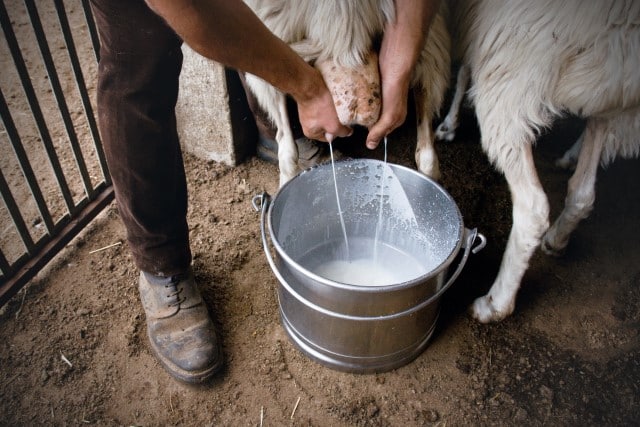
There should be a withdrawal period printed on every package insert or product label of federally-approved animal health products or drugs.
As long as a medication is used in accordance with its label, the withdrawal period for meat is usually between 0 and 60 days. When it comes to milk and cheese, however, the withdrawal periods are often different. Some types of medication may not be approved for dairy sheep at all.
Knowing the withdrawal periods of different kinds of drug are important when deciding which drug to give a sick sheep. There are some drugs that do not specify withdrawal periods, so that is something else to keep in mind.
If a drug isn’t being used in the way the label specifies, assume that there is a longer withdrawal period. If you are unsure what the withdrawal period is, ask your veterinarian. A vet will be able to consult with the Food Animal Residue Avoidance Database (FARAD).
This database gives the vet information on withdrawal periods when drugs are used for extra-label purposes. It’s also possible to find information on extra-label withdrawal periods by consulting scientific literature.
General Information on Antibiotics for Sheep
Most of us know that antibiotics are medications that are used for the treatment (and sometimes the prevention) of bacterial infections.
Be aware that different antibiotics can work differently and can be effective against different kinds of bacteria and disease. In many cases, a laboratory culture will be needed to find out which specific antibiotic will be needed to deal with a specific bacteria or disease.

Livestock producers should always limit the use of antibiotics to animals that are already sick or at real risk of getting sick. Improper use of antibiotics can quickly lead to the development of resistant bacteria. When this occurs, bacteria can present themselves that are extremely difficult (if not impossible) to treat.
Always maintain an accurate and highly detailed record of all the antibiotic treatments administered to your animals, as well as the outcomes.
While there are some antibiotics for sheep that are available without a prescription, I recommend that you get approval from your veterinarian before beginning any kind of antibiotic treatment for your sheep.
If there is a chronic infection in your flock that you are combatting, ask for general guidance that you can and should use when administering OTC antibiotics to your sheep.
FDA-Approved Antibiotics for Sheep and Lambs
If you are in the United States, you need to know which antibiotics have been approved by the FDA for giving to sheep and lambs.

The types of antibiotics that are approved will depend on the specific circumstances and use, so keep that in mind.
On January 1, 2017, the FDA determined that all antibiotics considered important for humans can only be given to sheep and mixed in their feed if there is a written order (directive) provided by a veterinarian. This means that you will need a prescription from your veterinarian. You will also need a veterinary prescription if you want to put any antibiotics in your sheep’s water. Here’s more on this 2017 directive:
At the moment, the only antibiotic approved for putting in sheep feed is aureomycin. the new regulations specific that aureomycin may be given to sheep at a rate of 80 mg per sheep per day (check with your vet for specifics however) in order to prevent abortion that can be caused by campylobacter spp.
You are never allowed to give antibiotics to lambs to improve feed efficacy and boost growth. This is now against regulations.
Below is a list of antibiotics the FDA has approved for sheep:
List of FDA Approved Antibiotics for Sheep
| Name of Antibiotic | Type of Antibiotic | Drug Ingredient | Use for Other Species (per label) |
|---|---|---|---|
| Cefa-Dri Tomorrow | OTC | Cephapirin Benzathine | For prevention of mastitis in dry cows |
| Cefa-Lak Today | OTC | Cephapirin Sodium | To treat mastitis in lactating cows |
| Draxxin | Rx | Tulathromycin | For treatment of conditions such as respiratory disease, foot rot, and keratoconjunctivitis in swine and cattle |
| Excede | Rx | Ceftiofur crystalline free acid | Use in horses and cattle |
| Excenel | Rx | Ceftiofur Hydrocloride | Use in cattle and horses as a broad spectrum antibiotic |
| Nuflor | Rx | Florfenicol | Use as a long-acting antibiotic in treating foot rot and respiratory disease in cattle |
| LA-200 LA-300 | OTC | Oxytetracycline | Used for swine and cattle as a long-acting broad spectrum antibiotic |
| Long-acting penicillin | OTC | Penicillin G Benzathine; Penicillin G Procaine | Used for cattle as a long-acting penicillin |
| Scour-Halt SpectroGard Scour-Check | OTC | Spectinomycin | Used for baby pigs as an oral antibiotic for treatment of e.coli scours |
| Sulmet | OTC | Sulfamethazine | Used for cattle and horses as an oral antibiotic |
| Tylan 50 | OTC | Tylosin | Used in cattle and swine as a broad spectrum antibiotic |
| Zactran | Rx | Gamithromycin | Used to treat respiratory diseases in cattle |
Antibiotics for Sheep (sub-therapeutic uses)
When antibiotics are used for sub-therapeutic purposes, it means they are used below the dosage level to treat an issue. There is a long history of sub-therapeutic levels of antibiotics being given to sheep for prevention of disease outbreaks.

Sub-therapeutic use of antibiotics for ewes in late pregnancy can help in abortion prevention. Ewes that have been given assistance in delivery of their lambs are usually recommended to be given antibiotics for the prevention of uterine infections.
Antibiotic use is prohibited by the USDA certified organic standards of livestock and meat production rules. Of course, a sick animal must always be treated and if antibiotics are required, they should be administered.
However, an animal that is being treated with antibiotics will not be able to be certified as organic. Milk and dairy products made from that animal cannot be utilized in the production of organic products.
What are Anthelmintics?
An anthelmintic is a type of medication that will kill worms. It is often referred to as an anti-parasitic drug or dewormer for sheep.
These kinds of drugs are available as pastes, drenches, injectables, boluses, pour-ons, and as products that you can mix with sheep feed. You can purchase this kind of medication over-the-counter.

The general recommendation is that sheep and lambs be treated with oral forms of this kind of medication. These are drenches and boluses. Oral formulations are typically more effective in sheep and lambs and there is less likelihood that they will lead to drug resistance.
If you are in the United States, you will find that these are the only kinds of products that the FDA approves for use in lambs and sheep. There are other kinds of newer anthelmintics, such as Startect and Zolvix available in other countries.
Small farms will be best served with tubes of deworming paste, and larger sheep farms should opt for liquid drench and administer it with a drench gun.
Properly Administer Anthelmintics to Your Sheep
Ensure that you always give your animals the proper dose of anthelmintics when treating them for internal parasites. If you give them too little of the medication, you are putting them at risk for drug-resistant worms.

You should administer these drugs using a syringe and over the sheep’s tongue. I prefer to push the drench gun or paste tube into the back corner of the sheep’s mouth to ensure the drug is swallowed.
Never try to squirt injectable dewormers in your animal’s mouth. Pour-on dewormers must never be given orally, either. Always carefully read the instructions that come with the product and follow them meticulously.
It isn’t recommended that you give dewormers to sheep on a scheduled basis or regular basis. You should integrate other kinds of worm control practices with targeted selective treatment (TST).
Effective worm control practices include mixed species grazing, pasture rotation and rest, zero grazing, alternative forages, and genetic selection.
The recommendation today is that clinically-parasized animals be treated with combination approaches. If you are in the United States, this will involve buying and administering each type of anthelmintic product separately. In other countries, there are combination products available.
You should never attempt to mix different anthelmintics yourself, as they do not have the proper chemical compatibility and this could be dangerous for your animals.
When you combine treatments, do so separately and consult with your vet. A full dose of each type of medication should be administered. When figuring out the withdrawal period for the medication treatment, use the longest withdrawal period specified for any of the products. This will often be Cydectin.
Below is a chart showing the anthelmintics the FDA has approved for use in sheep.
FDA Approved Anthelmintics for Sheep
| Name | Ingredient | Dosage | Withdrawal (for meat purposes) |
|---|---|---|---|
| Cydectin drench | Moxidectin | 1 ml/11 pounds | 7 days |
| Ivomec sheep drench | Ivermectin | 3 ml/26 pounds | 11 days |
| Valbazen drench | Albendazole | 3 ml/100 pounds | 7 days |
| Prohibit drench LevaMed drench | Levamisole | 1 oz/100 pounds 2 ml/50 pounds | 3 days |
If you are following USDA organic standards, be aware that a pregnant ewe may only be given anthelmintics during the final third of gestation. If an animal is going to be slaughtered, you cannot deworm it. A clinically-parasitized animal should always be treated for its condition.
However, if it is treated, it is no longer able to be sold as a certified organic product. This is true even if you observe extended withdrawal periods.
Synthetic Dewormer Alternatives
An alternative to synthetic dewormers can be copper oxide wire particles (COWP). Be careful with this, though. Remember that copper can quickly become toxic to sheep.
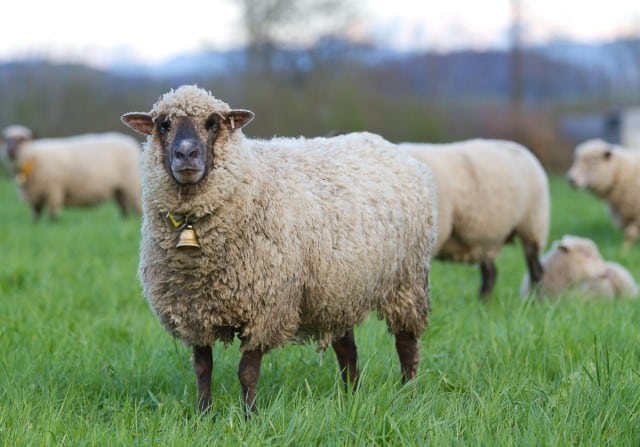
Copper oxide wire particles (COWP) are a less absorbable type of copper than regular copper. It has been shown to be effective against barber pole worm infections in both goats and sheep.
There has been research to show that when COWP is used in conjunction with a commercial dewormer (an example is Valbazen), treatment can be even more effective.
Boluses of COWP for sheep should be in smaller packages and doses than they are for goats and cattle. The dosages of this kind of treatment are based on age instead of weight. Make sure that you find out the current copper status of your animals before you use COWP for sheep.
What are Coccidiostats?
Coccidiostats are compounds that we add to animal feed to help prevent or delay the coccidia development. Coccidia is a protozoan parasite that damages and scours the small intestines, specifically their lining.

While the FDA has classified these drugs as antibiotics, the 2017 Veterinary Feed Directive did not affect them. That is because they are not of medical significance to humans.
If you are in the United States, you should be aware that Bovatec (lasalocid) has been approved for use as a coccidiostat in sheep kept in confinement. Between 20 and 30 grams of this drug can be mixed into one ton of feed for your sheep.
If you plan on being in the organic market, be aware that use of ionophores is not permitted under USDA rules. This is despite the fact that these drugs are not used in humans.
The approved coccidiostat for young sheep is called Decoxx (decoquinate). This drug can be mixed into a milk replacer or feed. In cases where other coccidiostats are found to be ineffective, a veterinarian can give you approval for extra-label use of Rumensin (monensin).
Follow Veterinary Guidance to Administer Coccidiostats
This drug can be toxic to sheep if it is not mixed and used properly, so careful veterinary guidance is critical here. You should also know that this drug is toxic to horses.
A drug called Corid (amprolium) is the sole coccidia drug that you are allowed to use as a preventative as well as a treatment when dealing with coccidiosis.
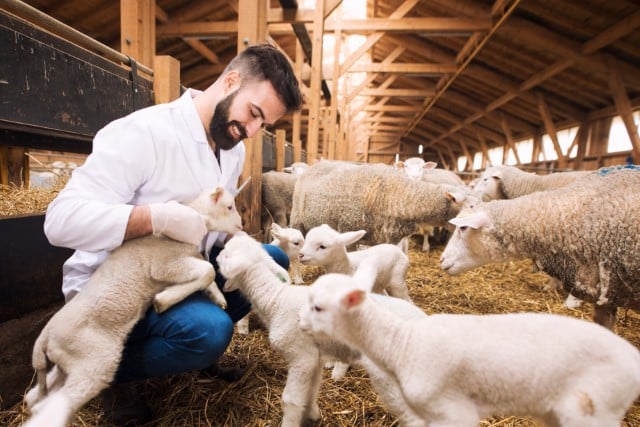
You can put it in the animals’ drinking water to stop coccidiosis outbreaks. However, it is more effective as a treatment than as a preventative. Corid is quite unique in the way it works. When it is ingested by the coccidia, it creates a thiamine deficiency. As a result, the parasites eventually die of malnutrition.
There are some other drugs that are used to treat coccidiosis on an extra-label basis. For example, sulfa drugs can be utilized in the treatment of coccidiosis. Similarly to Corid, sometimes sulfa antibiotics can be mixed into the drinking water.
They can also be administered as a drench.
Be aware, though, that sulfa antibiotics (and Corid) do not have FDA approval for using with sheep and goats without veterinary approval.
You should get sulfa antibiotics from your veterinarian.
Different Ways of Administering Medications to Sheep
Of course, the way a medication must be administered will depend on the type of medication and how its manufacturer’s instruction say it should be administered.
For prescription medication, make sure you follow the instructions your veterinarian provides, as well.
In many cases, the sheep will need to be correctly and humanely restrained before the medication is given.
Injections
Of course, needles and syringes used for injections must be clean and sterilized. When a needle is used to draw solution out of a bottle, it must also be sterile. After use, you should properly discard of all needles and syringes more on this later in the article).
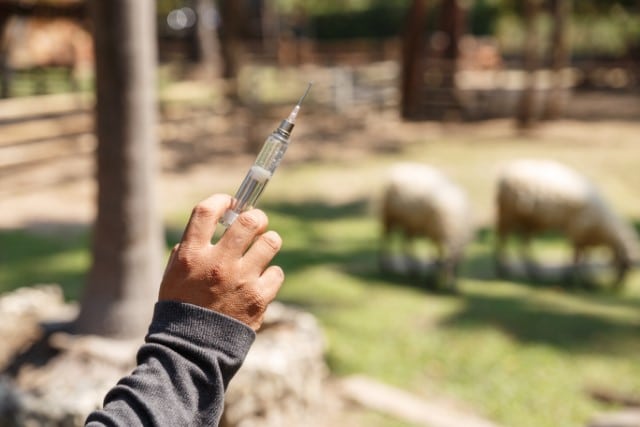
The thickness of the solution and the size of the sheep will factor in determining the gauge and length of the needle.
In general, it’s best to use the smallest gauge that will work as it should. When it comes to doing vaccinations, an 18-gauge needle about a half-inch in length is best.
Again, needles must only be used once. Remember to dispose of them after each and every use.
The Different Types of Injections
There are five types of injections (in terms of what part of the body you will administer the injection) for sheep.
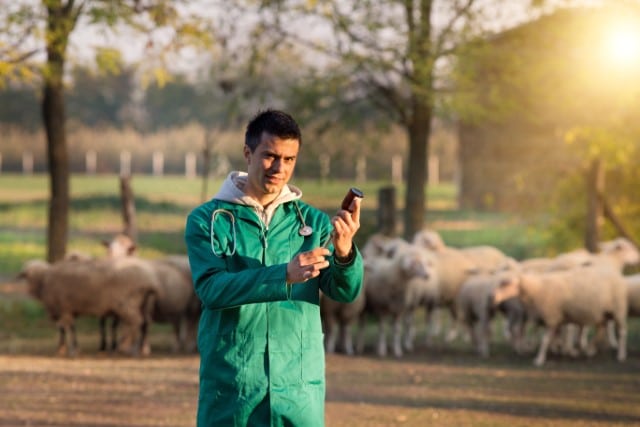
These include:
- Subcutaneous (SQ), or given under the skin in areas behind the shoulder, up on the neck, over ribs, or axilla (armpit)
- Intramuscular (IM) are given in the muscle (for example, the neck muscle)
- Intravenously (IV) or in a vein
- Intraperitoneal (IP) or into the peritoneum
- Intramammary injections are administered into the udder
When injections need to be given on a repeated basis, administer the second injection in the animal’s opposite side. You should never exceed 5 ml at a single site.
There aren’t very many drugs that require being administered intravenously. Doing intravenous injections can be very difficult to do. This is also the case with intraperitoneal injection. This kind of injection should be carried out only by someone who is highly skilled and understands the sheep’s anatomy.
An intraperitoneal injection being given incorrectly can lead to serious problems, such as peritonitis. This kind of injection is most often given to hypothermic lambs.
When intramammary injections (they are really infusions instead of injections) are administered, they are done using a long-neck tube rather than a needle. This tube must be extremely gently put into the teat sphincter.
Do not attempt this unless you are certain you know what you are doing. Ensure that the end of the teat is properly cleaned before you insert the tube. The tube itself, of course, must be clean and sanitary.
Most farmers will need to learn how to give intramuscular and subcutaneous injections to their flock, and the others should be handled by a veterinarian.
Drenching
Drenching is a procedure in which one administers liquid medicine orally. An oral syringe equipped with a long metal nozzle must be used for this process.
If you will be drenching a large number of sheep, you might want to use an automatic drench gun. I like this one, available on Amazon.

When you are getting ready to drench a sheep, you must put one hand under the sheep’s head and tilt the head slightly to its side. Place the nozzle of the automatic drench gun in the gap separating the sheep’s incisor teeth and the molar and then on top of the back of the tongue.
You cannot just put the medicine in the sheep’s mouth and hope it will swallow it, because it might then bypass the rumen as it goes down the esophageal groove. After the animal swallows, take out the automatic drench gun.
Never attempt to do drenching simply by pouring something into an animal’s mouth. This can lead to aspiration pneumonia (this is a lung infection caused by foreign material being breathed in).
When drenching animals, you need to hold the head horizontally to avoid liquid from getting into the bronchial tubes or lungs.
Drenching must always be done humanely. Never attempt to do drenching faster than the sheep can swallow and never try to force anything down an animals’ throat.
Boluses
Boluses (or capsules) may be given to sheep and lambs through use of a balling gun like this one on Amazon. A balling gun is a metal or plastic tube. One end of it has a capsule holder and the other end has a plunger.

The plunger is what ejects capsules. You can buy balling guns in a variety of sizes, but smaller is generally better for sheep, as some of the ones you’ll find online are designed for cattle and horses, which are much larger animals.
You can use young animal balling guns for both lambs and sheep. Look for one that’s about a foot long, like this 13″ model.
With giving boluses, the balling gun is put into the sheep’s mouth in the same way you do drenching. The balling gun should be over the base of the tongue before you press the plunger. If you don’t get it right, the animal may spit out or chew the pill.
Do not shove the end of the bolus gun too deeply into the throat, as this can cause damage and pain to the animal. I find that it’s best to slightly raise the sheep’s head and gently massage its neck, holding the mouth closed after administering the pill. This is similar to how you would give pills to a dog.
The trick is the placement of the bolus. You want it far enough back so that it’s behind the tongue and easily swallowed, but not so far back that it triggers a gag reflex. It takes practice, so don’t get discouraged when the sheep spits out your pill the first few times you try it.
Proper Disposal of Sharps
Remember that all sharps (syringes, needles, slides, scalpel blades, and any other instrument that can puncture) must be correctly disposed of. Collect all sharps on the farm in a container that is rigid and puncture-resistant. Properly secure it with a screw-on lid tightly in place.
You can use anything for this, but home-use sharps containers designed for the purpose are available on Amazon and typically run $6-10.

If you don’t use a pre-marked container, put a label indicating biohazardous material inside on the lid.
After a container is full, you should bring it to an approved collection facility, especially designated for medical and veterinary waste.
You can search “medical waste disposal near me” on Google to find a nearby site.
Other Kinds of Injectables for Sheep
There are other kinds of injectable medication that are approved for use with sheep.
In order for a farmer to be able to give his or her sheep many of the medications listed below, he or she must buy the products from a veterinarian and use them under the guidance of that professional.
| Medication Name | Labeled Use | Dosage Information | Rx or OTC? |
|---|---|---|---|
| Banamine | Anti-pain and anti-inflammatory | Consult your veterinarian | Rx |
| BO-SE | Prevention and treatment of selenium deficiency | For sheep, dosage is 2.5 ml/100 pounds. For lambs, it is 1 ml/40 pounds | Rx |
| Calcium gluconate | Treatment of milk fever that can be caused by calcium deficiency | 50-100 ml of a 23% solution, IV | OTC |
| Dexamethasone | Anti-pain and anti-inflammatory | Consult with your veterinarian | Rx |
| Dextrose, 50% | Used for glucose deficiency (for example, ketosis). Also used as a nutrient replenisher. | 50 cc/100 pounds. IV | OTC |
| Epinephrine | For treating anaphylactoid shock | 1 ml/100 pounds, SQ | Rx |
| Iron Dextran | Prevention and treatment of iron deficiency (most commonly used for baby pigs) | OTC | |
| Thiamine HCL, Vitamin B1 | For treatment of thiamine deficiency | Consult with your veterinarian | Rx |
| Vitamin B Complex | For treatment of deficiencies in B vitamins, as well as to provide vitamin B supplements | 5 cc/100 pounds. IM | OTC |
| Vitamin E-300 | For correction of vitamin E deficiencies | For ewes, 4-5 ml IM or SQ For lambs, 2-4 ml IM or SQ | OTC |
| Vitamin E – AD | For a supplemental source of natural vitamin E, vitamin E, and vitamin D3 | OTC |
Important Medications to Have On Hand for Sheep
So – what should you have on hand at your farm in case of an emergency?
Below is a list of oral treatments commonly used for sheep. These can generally be bought over-the-counter without consulting a vet.

These oral medications most often treat sheep that have digestive issues. Some are designed to give stressed or sick animals supplemental nutrition.
| Name of Medication / Product | Use on the Farm |
|---|---|
| Electrolytes (several different brands) | To provide supplemental fluids and electrolytes. For rehydration of animals suffering from sickness. |
| Bisusal (bismuth subsalicylate) | This medication is used to deal with non-infectious diarrhea. |
| Sheep Nutri-Drench | This is a nutritional supplement used for stressed lambs and sheep. |
| Kao-Pec Kaolin-Pectin Same as Kaopectate | This medication is used to deal with non-infectious diarrhea. |
| Vitamin E and Selenium oral gel | This is provided as a supplemental source of selenium and vitamin E. |
| Therabloat (poxalene) or Durvet Bloat Treatment for Sheep | This is used for treatment of frothy bloat sometimes seen in cattle. |
| Red Cell | This is an iron supplement and vitamin and is used for treating anemia. It does contain, copper, however, so extreme caution must be used when using it with sheep. Check your sheep’s copper status first. |
| Propylene glycol | This medication is used to prevent and treat ketosis, a problem often found in dairy cattle. Sheep can suffer from toxemia as well. |
| Probios oral gel | This oral gel is used to provide healthy bacteria for the animal’s digestive system. |
| Power Punch | Power Punch is a nutritional supplement that is given to stressed animals. |
| Mineral Oil | Mineral oil may be used as a mild laxative. |
Vaccines Approved for Sheep and Lambs
When vaccinations are used in an annual program, the initial dose is administered in the first year then booster shots are administered in subsequent years to ensure maximum protection.
The majority of vaccines are given by way of subcutaneous (under-the-skin) injection.
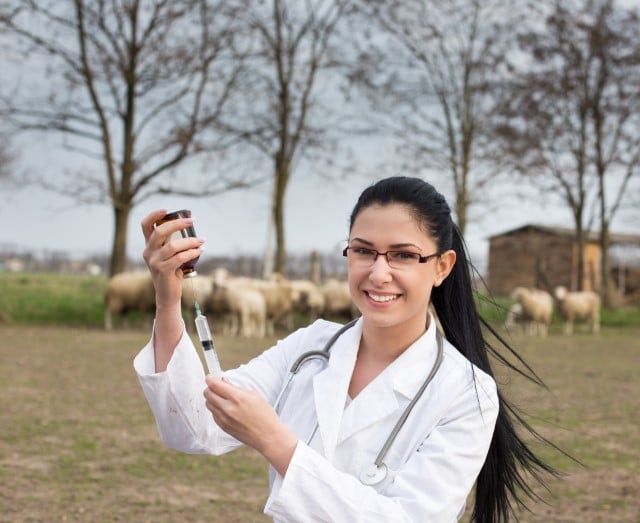
Below is a chart listing vaccines that have been labeled for use in sheep and lambs:
Sheep Vaccine List
| Vaccine | Dosage | Meat Withdrawal Period |
|---|---|---|
| Volar footrot bacterin | 3 ml SQ or IM. Is repeated in between 3 and 4 weeks, and there is an annual booster or before potential outbreaks | 21 days |
| Campylobacter | 5 ml SQ shortly prior to breeding taking place. Repetition in 60-90 days. Annual revaccination (single dose). | 21 days |
| Tetanus antitoxin | For prevention: 1,500 units For treatment: 3,000-15,000 units, SQ or IM | 21 days |
| Case-Bac | 2 ml SQ. Another 2 ml dose in 4 weeks. Annual revaccination (single dose) | 21 days |
| Caseous D-T | 2 ml SQ. Another 2 ml dose in 4 weeks. Annual revaccination (single dose) | 21 days |
| C&D antitoxin | 5 ml SQ for suckling lambs. 10 ml SQ for feeder lambs. If being used for treatment, double dosage. | 21 days |
| CD-T | 2 ml SQ. Repeated in 21-28 days. Annual revaccination | 21 days |
| Covexin 8 | 5 ml SQ. Six weeks later, a 2 ml dose. Annual revaccination with 2 ml. | 21 days |
| Chlamydia | 60 days before breeding, 2 ml SQ. A repeat dose 30 days after that. Annual revaccination (single dose) | 60 days |
| Epididmymitis | 2 ml SQ. A repeat dose in 30 to 60 days. Booster on an annual basis. | 21 days |
| Footvax | Before anticipated outbreak, 1 ml SQ. Repeated in 6 weeks to 6 months. An annual booster. | 60 days |
| Ovine Ecolizer | Within 12 hours of birth, 5 ml administered orally | 21 days |
| Pasteurella | 2 ml SQ. Repeated in 2-4 weeks. | 21 days |
| Rabies | 2 ml IM. Revaccination annually. | 21 days |
| Soremouth | One drop is applied to scarified area | 21 days |
Please remember, that all dosage information provided in this article is accurate to the best of my ability, but you should always follow the product label and consult with your veterinarian.

